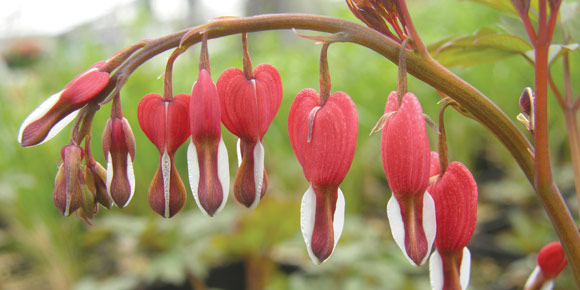A big patch of bleeding heart is a boon to hummingbirds that are this lovely plant’s main pollinator. The tiny birds slip their long slender bills between the pink petals and up into the nectar-rich, white interior.
Most gardeners know bleeding heart botanically as Dicentra spectabilis. The word dicentra is from the Greek: dis meaning twice and kentron, meaning spur. Now the ever-busy plant classifiers have set one variety aside in a class of its own and now call it Lamprocapnos, but all agree that it is still pretty spectabilis! These naming wars make no difference to the gardener, who will always call this pretty plant bleeding heart, no matter what the experts say.
Bleeding hearts have other names. A wild North American variety is called Dutchman’s breeches. Another name is lyre flowers, for its graceful shape. Turn it upside down, pull back the breeches and suddenly you see the reason some people call it lady-in-a-bath. The common name of one variety from eastern North America is squirrel corn for its tight, corn-like clusters of bulbets.
Many bleeding heart varieties are rhizomatous, sending out runners underground. Others have root bulbets shaped like little teardrops
Scottish smuggler
Scottish botanist and plant smuggler, Robert Fortune, is credited with bringing bleeding heart to the Royal Botanic Garden in Edinburgh between 1848 and 1851. He was a busy man in his short time in the Far East, being the one who smuggled tea out of China and into India. Export of Camellia sinensis from China was forbidden at the time.
Many bleeding hearts are ephemerals, meaning that they bloom then die back early in the year. While their pretty, deeply dissected leaves would be a plus in any garden, those that die back can open up room for a late blooming plant in a full perennials garden.
Dicentra root can numb gums
Deer are pretty smart. They tend to avoid their alkaloid-filled stems and foliage. Somehow, they know that eating bleeding heart parts can cause trembling, vomiting, diarrhea, convulsions and trouble breathing. However, if you have a toothache, dicentra root can numb your gums and help you through it.
‘Gold Span’ has golden yellow foliage. ‘Alba’ has all white flowers. Both are lovely. Grow them in light to medium shade in a well-drained location. If planting from seed, sow in fall so that the seeds can go through scarification (exposure to cold). The plants will emerge early in spring, growing from one to three feet tall and wide. Each raceme will produce about 20 delicate blossoms.
Planting help from ants
If a lovely bleeding heart has shown up, unaided, in your garden it may have been planted by an ant from a neighbouring yard. Bleeding heart seeds contain eliosome, lipids or molecules that include a lot of ant nourishment, including vitamins such as A, D, E and K, not to mention all the glycerides, as well as fats, waxes and sterols. Ants gather the seeds, eat the eliosome and toss the remaining seed, unharmed, in their midden, where it often sprouts.
Bleeding hearts have brittle, tuberous roots that will break off easily when being transplanted. They are easy to increase by dividing every five years or so. Long lived perennials, they will grow happily for 30 years without transplant.
Dorothy dobbie is the owner of Manitoba Gardner magazine. If you would like to subscribe, go to www.localgardner.net or call 204 940 2700 and Jane will be happy to help you.



